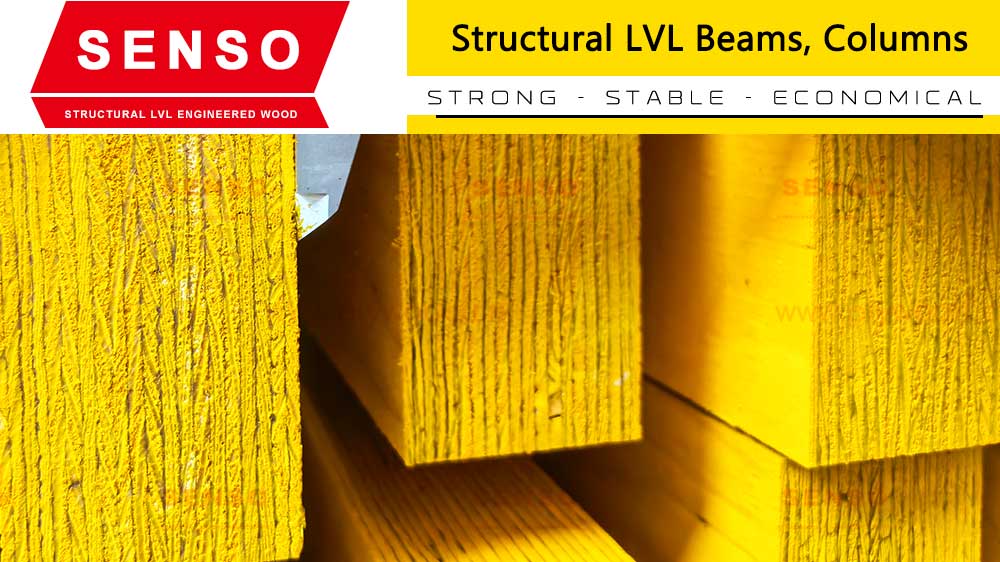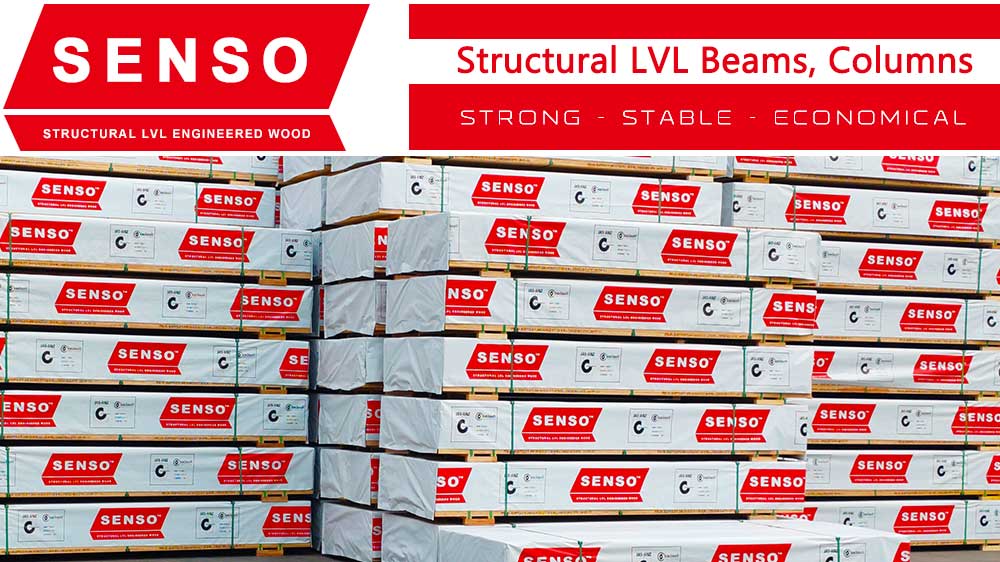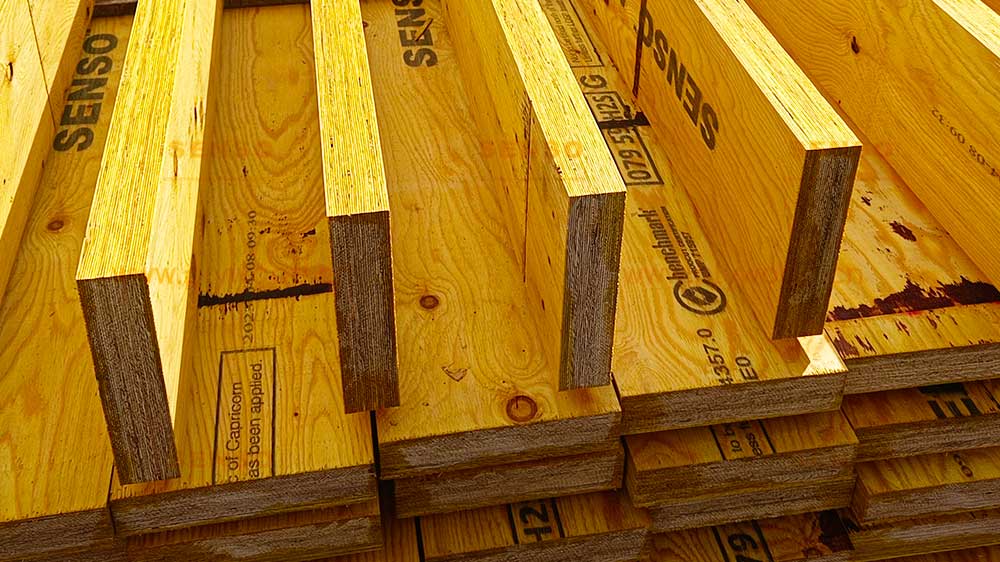What Are Ceiling Wood Beams Fake?
Ceiling wood beams fake, also called faux or imitation beams, are used to enhance ceiling design in homes. They look like real timber beams but are made from light materials like polyurethane or resin. This makes them simple to handle and quick to install. They are crafted to mimic natural wood grain. These fake beams come in many finishes and styles. Options range from rustic barn looks to clean, modern designs. Homeowners get real wood appearance without the heavy cost or weight.
Traditional timber beams, including LVL beams, are strong and used in structural framing. They support weight in buildings and roofs. In contrast, fake ceiling beams serve only as decoration. They add visual appeal but offer no structural support. They are commonly used to add character to a room, create architectural interest, or cover unsightly wiring and ductwork. Fake beams use non-structural materials like polyurethane or foam. This makes them much lighter than real wood beams. They are easy to lift, cut, and mount. Their light weight helps speed up installation. DIYers and interior designers find them ideal for quick and stylish upgrades.
Fake ceiling beams are available in a variety of sizes, allowing them to fit different room configurations. Ceiling wood beams fake, also called faux or imitation beams, are used to upgrade and decorate ceiling spaces. These beams copy the look of real timber but use lightweight materials like polyurethane or resin. This makes them simple to move and easy to install. They are styled to look like natural wood grain. Fake ceiling beams come in many finishes and styles. From rustic barn wood to modern designs, they give a timber look without the high cost or heavy weight.
The Benefits of Ceiling Wood Beam Fake
Ceiling wood beams fake offer several advantages over traditional timber beams, making them an increasingly popular choice for both residential and commercial spaces. From ease of installation to cost savings, these beams provide the perfect balance between style and practicality.
Affordability
One of the main reasons homeowners and designers choose ceiling wood beams fake is their affordability. Real timber beams, including large LVL beams, often cost more because of materials, production, and installation work. These beams are heavy and need extra labor. In contrast, fake beams use budget-friendly materials like polyurethane. They are lighter and easier to work with. This makes them a smart, cost-effective option to get the same wood-beam look.
Homeowners who want to remodel or add charm without overspending will find fake beams a great choice. These beams look like real wood but cost much less. This allows you to stay on budget. You can spend more on other design features. They give style and warmth without the high price of timber.
Lightweight and Easy to Install
Another significant benefit of fake ceiling beams is their lightweight nature. Traditional timber beams, like LVL beams and lumber LVL beams, are heavy and hard to install. They often need special tools and trained professionals. Moving them safely requires more effort. On the other hand, fake beams are light and simple to work with. One or two people can easily lift and install them without extra help.
Because they are lighter, fake beams do not require the same level of structural support as real wood beams. This reduces the time and cost associated with installation, making them a popular choice for DIYers looking to enhance their space without the need for professional contractors.
Versatility in Design
Fake ceiling beams are available in a wide range of styles, finishes, and sizes, allowing for endless design possibilities. Whether you prefer the rustic look of reclaimed barn wood or the sleek, modern lines of smooth timber beams, there is a fake beam option to suit your taste. Additionally, fake beams can be easily painted, stained, or distressed to achieve a custom look that complements your existing decor.
Homeowners who want a traditional or historic vibe can use fake beams to copy the look of exposed timber beams. These beams resemble those found in older homes. You can arrange them in creative layouts. Grid patterns or vaulted ceiling designs are popular choices. They add depth and architectural charm. Fake beams help transform plain ceilings into elegant and eye-catching spaces.
Low Maintenance and Durability
Real wood beams need regular care to avoid warping, cracking, or pest damage. These issues can add to long-term costs. Fake ceiling beams offer a better, low-maintenance option. They are made from strong materials like polyurethane or resin. These materials resist moisture, bugs, and damage from weather. As a result, the beams keep their look and strength for many years with very little upkeep.
In areas with high humidity or moisture levels, such as bathrooms or basements, fake beams are an ideal choice because they do not absorb moisture and are less prone to damage. This durability makes them a practical option for homeowners seeking a long-lasting, low-maintenance decorative solution.
LVL Beams vs. Ceiling Wood Beams Fake
Laminated veneer lumber (LVL) beams and fake ceiling wood beams serve different purposes in construction and interior design. LVL beams are structural elements used to provide support in buildings, while fake beams are purely decorative. Understanding the differences between these two types of beams can help you choose the right option for your project.
LVL Beams for Structural Support
LVL beams are built by gluing thin wood veneer layers together. They are pressed under high pressure for extra strength. This process creates a strong, stable structural beam. LVL beams are often used in modern construction projects. They support roofs, floors, and walls with ease. Compared to regular timber, they offer better strength and higher load-bearing performance. LVL beams are also more resistant to warping and shrinking, making them a reliable choice for structural applications.
LVL beams work well for load-bearing needs but are not often used as decor because of their plain, functional look. They are made for strength, not style. However, some designs embrace their raw appearance. In industrial or modern spaces, exposed LVL beams add character. This is popular in open-plan layouts where structural parts are meant to be seen and appreciated.
Fake Ceiling Beams for Decoration
In contrast, fake ceiling beams are designed solely for decorative purposes. Unlike LVL beams, they do not provide structural support and are not intended to bear weight. Instead, they are used to enhance the appearance of a room by adding visual interest to the ceiling. Fake beams can be used in both traditional and modern settings, depending on the style and finish chosen.
Because they are not load-bearing, fake ceiling beams offer more flexibility in terms of placement and design. Fake beams can go where real timber is too heavy or not suitable. This includes vaulted ceilings or tight spaces. Their light weight makes them perfect for tricky installations. They can also hide wires or ducts. This creates a neat, polished appearance. You don’t need major renovations. Fake beams offer both function and beauty with less effort and lower cost.
Design Ideas for Ceiling Wood Beams Fake
Ceiling wood beams fake can be used in a variety of ways to transform the look of a space. Whether you’re looking to create a cozy, rustic atmosphere or a sleek, contemporary feel, fake beams offer endless design possibilities.
Rustic Barn Wood Beams
For homeowners who love the look of reclaimed wood, fake ceiling beams in a rustic barn wood finish are a great option. These beams mimic the weathered, aged appearance of real barn wood, adding warmth and character to any room. Rustic beams are especially popular in farmhouse-style homes, where they can be paired with natural materials such as stone or brick for an authentic, cozy feel.
Modern and Minimalist Designs
Fake ceiling beams are not limited to traditional or rustic styles—they can also be used in modern and minimalist spaces. For a sleek, contemporary look, opt for smooth, straight beams in a neutral color such as white or gray. These beams can be arranged in geometric patterns, such as a grid or box-beam design, to create clean lines and add architectural interest to the ceiling.
In open-plan rooms or loft apartments, fake beams help define spaces without adding walls or physical dividers. They offer structure without blocking light. Install beams above the dining table or lounge area to create visual separation. This keeps the room feeling spacious and bright. It’s an easy way to shape your space while keeping an open, modern design.
Vaulted Ceilings with Faux Beams
Vaulted ceilings are a dramatic architectural feature that can be further enhanced with the addition of fake ceiling beams. By installing beams along the peak of the ceiling or in a crisscross pattern, you can draw attention to the height and create a stunning focal point in the room.
Fake beams work especially well on vaulted ceilings. They are lightweight and simple to handle, even in tall or tricky spots. You can install them without heavy lifting gear. There’s no need for extra support structures. They create the look of real timber beams with much less effort and lower installation demands.
Installing Ceiling Wood Beams Fake
Installing ceiling wood beams fake is a relatively simple process that can be completed by DIY enthusiasts or professional installers. Because these beams are lightweight and do not require the same level of structural support as real wood beams, the installation process is much quicker and more cost-effective.
Step-by-Step Guide to Installing Ceiling Wood Beams Fake
Installing fake ceiling beams can greatly improve how a room looks. The process is easier than most people expect. Installation steps can differ based on beam type and ceiling surface. However, the overall method stays simple. Most homeowners or contractors can complete it with basic tools. It’s a fast way to add charm and character.
1. Measure and Plan the Layout
Before you begin installation, it’s essential to measure the ceiling and plan the layout of the beams. Determine where you want to place the beams—whether it’s a simple parallel arrangement, a grid pattern, or along the peak of a vaulted ceiling. Measure the length and width of the area to ensure that your beams will fit correctly.
When installing beams over ceiling features like lights or fans, make sure to leave enough space for clearance. Plan ahead to avoid blocking fixtures. Beam spacing also matters. It should match the room size and your design goals. Proper layout ensures a balanced, stylish look that feels natural and well-planned.
2. Cut the Beams to Size
Most ceiling wood beams fake are sold in standard sizes, so you may need to cut them to fit your specific measurements. Use a saw to cut the beams to the correct length, making sure to keep the cuts as straight and clean as possible.
If your design includes angled cuts (such as in a vaulted ceiling), take extra care to measure and cut accurately. It may be helpful to use a miter saw to achieve precise angles for beams that meet at the ceiling’s peak.
3. Mark the Ceiling
Once your beams are cut to size, mark the ceiling where each beam will be installed. You can use painter’s tape or chalk lines to map out the placement of the beams. This step is crucial for ensuring that the beams are evenly spaced and aligned properly.
In cases where the beams will be mounted to a vaulted ceiling or a ceiling with angles, mark both the top and bottom edges of the beams to ensure they follow the ceiling’s contours.
4. Attach Mounting Blocks or Brackets
Since fake beams are lightweight and not load-bearing, they can be easily attached to the ceiling using mounting blocks or brackets. Mounting blocks are typically small wooden or metal pieces that are screwed into the ceiling joists. These blocks act as a support system for the beams and will be hidden once the beams are in place.
For ceilings without joists in the desired beam locations, you can use heavy-duty wall anchors or toggle bolts to secure the mounting blocks to the ceiling. Be sure to use appropriate fasteners that can support the weight of the beams.
5. Install the Beams
After the mounting blocks or brackets are securely attached, it’s time to install the beams. Fake ceiling beams are typically hollow, allowing them to slide over the mounting blocks. Gently slide each beam into place, ensuring it fits snugly around the mounting blocks.
Once the beam is in position, secure it by using screws or adhesive, depending on the manufacturer’s recommendations. Be sure to check that each beam is level and aligned with your marked ceiling lines before fully securing it in place.
6. Touch Up and Finish
After the beams are installed, the final step is to touch up any gaps or seams where the beams meet the ceiling. You can use caulk or wood filler to fill in any gaps, ensuring a smooth, finished look. If the beams are painted or stained, touch up the areas where they were cut to match the rest of the beam.
Once the touch-ups are complete, you can step back and admire your newly transformed ceiling!
Faux Beams for Different Ceiling Types
Ceiling wood beams fake can be installed on a variety of ceiling types, including flat, vaulted, and tray ceilings. Each type of ceiling offers unique design opportunities, and faux beams can be customized to suit the space.
Flat Ceilings
For flat ceilings, fake wood beams can be arranged in a variety of patterns to create visual interest. One popular option is to install beams in parallel lines across the ceiling, creating a classic, symmetrical look. This works particularly well in large rooms where the beams can help break up the flat surface and add texture.
Alternatively, beams can be installed in a grid pattern, which adds a sense of depth and dimension to the ceiling. This pattern is commonly used in traditional and formal spaces, such as dining rooms or living rooms, to create an elegant, structured look.
Vaulted Ceilings
Vaulted ceilings offer the perfect canvas for faux beams. The beams can be installed along the slope of the ceiling, highlighting its height and adding architectural interest. In some cases, beams can be crisscrossed or arranged in a “king post” pattern, creating a stunning focal point in the room.
Because fake beams are lightweight, they can be easily installed on vaulted ceilings without the need for additional structural support. This makes them an excellent option for homeowners who want to enhance the look of their vaulted ceiling without the expense and hassle of using real wood beams.
Tray Ceilings
Tray ceilings, which feature a recessed central section, can be beautifully accented with faux beams. The beams can be installed around the perimeter of the recessed area to emphasize the ceiling’s design and add a sense of depth.
In some cases, homeowners may choose to install faux beams within the recessed area, creating a coffered effect. This can add a dramatic, custom feel to the room and make the tray ceiling stand out as a unique architectural feature.
How Fake Ceiling Beams Compare to Real Wood Beams
While fake ceiling beams provide the look of real wood, there are several key differences between the two options. Understanding these differences can help you decide which type of beam is best for your project.
Weight and Ease of Installation
As mentioned earlier, one of the biggest advantages of fake ceiling beams is their lightweight nature. Real wood beams, especially large timber beams or LVL beams, are heavy and require substantial structural support. This can make installation more complex and costly.
Fake beams, on the other hand, are much lighter and easier to install. Because they do not require the same level of support as real wood beams, they can be installed quickly and without the need for professional contractors in many cases. This makes fake beams a more accessible option for DIYers and homeowners looking to update their space.
Cost
Another significant difference between real wood beams and fake beams is cost. Real timber beams, particularly large LVL beams or reclaimed wood beams, can be expensive due to the cost of materials, manufacturing, and installation. In contrast, fake beams are more affordable, making them a budget-friendly option for achieving the same aesthetic.
For homeowners looking to achieve the look of real wood beams without the associated costs, fake beams offer an excellent alternative. They provide the same visual impact at a fraction of the price, making them a practical choice for remodeling projects.
Durability and Maintenance
Real wood beams need frequent care to avoid warping, cracking, or damage from pests. These issues can raise maintenance costs over time. Fake beams are a better long-term option. They are made from strong materials like polyurethane or resin. These materials resist moisture, insects, and weather. This helps fake beams keep their look and strength with very little upkeep.
Fake beams are perfect for humid areas like bathrooms or kitchens. Real wood can warp or crack in these damp spaces. Fake beams resist moisture and stay looking great. They don’t need sealing or regular treatment. This saves time and money on maintenance. Over the years, they offer big cost savings and keep your space looking fresh and stylish.
Faux Beams and Interior Design Trends
Ceiling wood beams fake have become a popular choice in interior design due to their versatility and aesthetic appeal. From traditional homes to modern lofts, fake beams can be used to enhance a wide range of design styles.
Farmhouse Style
The farmhouse style, characterized by its rustic, cozy aesthetic, has become one of the most popular interior design trends in recent years. Fake wood beams, especially those with a reclaimed or distressed finish, are a natural fit for this style. When paired with natural materials like stone, brick, or shiplap, these beams can add warmth and character to any room.
Modern and Industrial Design
In modern and industrial spaces, faux beams are often used to create a sleek, minimalist look. Smooth, straight beams in neutral colors like white or black can add architectural interest without overwhelming the space. When used in loft-style apartments or open-plan homes, these beams can help define different areas while maintaining the overall flow of the room.
FAQs About Ceiling Wood Beams Fake
Q: What are ceiling wood beams fake made of?
A: Ceiling wood beams fake are typically made from lightweight materials like polyurethane, resin, or high-density foam, making them easy to install and maintain.
Q: Can fake ceiling beams be installed on any type of ceiling?
A: Yes, fake beams can be installed on a variety of ceiling types, including flat, vaulted, and tray ceilings. They are lightweight and easy to install.
Q: Do fake ceiling beams look like real wood?
A: Yes, fake ceiling beams are designed to closely resemble real wood. They come in a variety of finishes, from rustic to modern, and can be customized to match the look of natural timber.
Q: Are ceiling wood beams fake durable?
A: Yes, fake beams are highly durable. They are resistant to moisture, insects, and environmental wear, making them suitable for long-term use in a variety of settings.
Q: How much do fake ceiling beams cost compared to real wood beams?
A: Fake ceiling beams are typically more affordable than real wood beams, especially large timber or LVL beams. They provide the same visual impact at a lower cost.
Post time: Apr-28-2025




